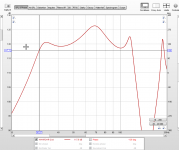So basically for subwoofers, it's all about looking at the Vd = xmax * Sd for a given SPL.
So let's say you want (roughly) the same output as a 10inch driver (330 cm²) with a 8mm xmax.
If we assume that the 4 inch (56 cm²) drivers will have the same xmax (which is practically close to impossible) 330 / 56 = 5.89 => 6 drivers.
But if we check how much we need in a real situation, let's say xmax of 4.5mm for a 4 inch; (330 * 8 ) / (56 * 4.5) = 10.5 => 11 woofers
But this is not to entire story.
Generally speaking, bigger woofers tend to distort (a lot) less.
One of the reasons is that higher cone excursion means more non-linearities (= distortion)
So in the end a bigger subwoofer would likely perform better.
Not taking things like power dissipation into consideration
Although the word better is very subject obviously, all depending on context
In certain situations you just have to fit it all in, somehow
Maybe there is no space for a bigger woofer etc
So let's say you want (roughly) the same output as a 10inch driver (330 cm²) with a 8mm xmax.
If we assume that the 4 inch (56 cm²) drivers will have the same xmax (which is practically close to impossible) 330 / 56 = 5.89 => 6 drivers.
But if we check how much we need in a real situation, let's say xmax of 4.5mm for a 4 inch; (330 * 8 ) / (56 * 4.5) = 10.5 => 11 woofers
But this is not to entire story.
Generally speaking, bigger woofers tend to distort (a lot) less.
One of the reasons is that higher cone excursion means more non-linearities (= distortion)
So in the end a bigger subwoofer would likely perform better.
Not taking things like power dissipation into consideration
Although the word better is very subject obviously, all depending on context
In certain situations you just have to fit it all in, somehow
Maybe there is no space for a bigger woofer etc
Right, also need to consider that to perform as a single big one the usable BW can be [considerably] < the larger driver's unless there's enough distance to the LP for it to coalesce.
Something that hasn't been discussed yet would be this: instead of putting 16x 4" drivers in a box, what about building 16x tiny boxes, and distributing them?
In comparison to a single large subwoofer, the in-room response could be hugely improved. With suitably small boxes, they could be hidden entirely.
Depending on the granularity of control desired, the processing and amplification could get quite complex. The results could be excellent, though.
Chris
In comparison to a single large subwoofer, the in-room response could be hugely improved. With suitably small boxes, they could be hidden entirely.
Depending on the granularity of control desired, the processing and amplification could get quite complex. The results could be excellent, though.
Chris

Simulated 117 dB @ 30 Hz from 4 X 4″ SB12PAC25-4 drivers in separate corner loaded HROAR4.
The 4″ SB12PAC25-4 4″ SB12PAC25-4 / Aluminium - Sbacoustics are very cheap but nice drivers. I have 6 pieces of those, so I have been fooling around with this exact idea in Hornresp and on paper a while now.
Something that hasn't been discussed yet would be this: instead of putting 16x 4" drivers in a box, what about building 16x tiny boxes, and distributing them?
In comparison to a single large subwoofer, the in-room response could be hugely improved. With suitably small boxes, they could be hidden entirely.
Depending on the granularity of control desired, the processing and amplification could get quite complex. The results could be excellent, though.
Chris
Obviously it depends on your ultimate goal but I wouldn't put 16 identical units in the same room. It doesn't bear comparison but I currently have three subs in one room (two identical). The front pair are spaced 7ft apart either side of a TV unit and are crossed at 120hz. Utilising one sub the system sounds okay. The unforeseen benefit of adding its twin is that the bass traps in apartment are less pronounced. Powering on the third, differently specified, rear sub resulted in boomy, muddy, lingering bass. But crossing that at 40hz provides nice, invisible reinforcement.
If I was to follow your theory I'd probably use eight ported cabinets each containing two drivers and tune the ports of each pair of cabinets slightly differently, say: 45Hz, 52Hz, 60hz, 68hz. See how that works out.
View attachment 954091
Simulated 117 dB @ 30 Hz from 4 X 4″ SB12PAC25-4 drivers in separate corner loaded HROAR4.
The 4″ SB12PAC25-4 4″ SB12PAC25-4 / Aluminium - Sbacoustics are very cheap but nice drivers. I have 6 pieces of those, so I have been fooling around with this exact idea in Hornresp and on paper a while now.
I'd be very interested in learning more about the HROAR4 design.
Thanks